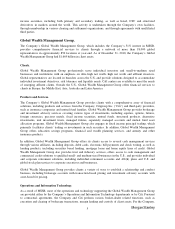Morgan Stanley 2010 Annual Report Download - page 21
Download and view the complete annual report
Please find page 21 of the 2010 Morgan Stanley annual report below. You can navigate through the pages in the report by either clicking on the pages listed below, or by using the keyword search tool below to find specific information within the annual report.
FDIC Regulation. An FDIC–insured depository institution is generally liable for any loss incurred or expected
to be incurred by the FDIC in connection with the failure of an insured depository institution under common
control by the same bank holding company. As FDIC-insured depository institutions, MSBNA and MS Private
Bank are exposed to each other’s losses. In addition, both institutions are exposed to changes in the cost of FDIC
insurance. In 2010, the FDIC adopted a restoration plan to replenish the reserve fund over a multi-year period.
Under the Dodd-Frank Act, some of the restoration must be paid for exclusively by large depository institutions,
including MSBNA, and assessments are calculated using a new methodology that generally favors banks that are
mostly funded by deposits.
Institutional Securities and Global Wealth Management Group.
Broker-Dealer Regulation. The Company’s primary U.S. broker-dealer subsidiaries, MS&Co. and MSSB
LLC, are registered broker-dealers with the SEC and in all 50 states, the District of Columbia, Puerto Rico and
the U.S. Virgin Islands, and are members of various self-regulatory organizations, including the Financial
Industry Regulatory Authority, Inc. (“FINRA”), and various securities exchanges and clearing organizations. In
addition, MS&Co. and MSSB LLC are registered investment advisers with the SEC. Broker-dealers are subject
to laws and regulations covering all aspects of the securities business, including sales and trading practices,
securities offerings, publication of research reports, use of customers’ funds and securities, capital structure,
recordkeeping and retention, and the conduct of their directors, officers, representatives and other associated
persons. Broker-dealers are also regulated by securities administrators in those states where they do business.
Violations of the laws and regulations governing a broker-dealer’s actions could result in censures, fines, the
issuance of cease-and-desist orders, revocation of licenses or registrations, the suspension or expulsion from the
securities industry of such broker-dealer or its officers or employees, or other similar consequences by both
federal and state securities administrators.
The Dodd-Frank Act includes various provisions that affect the regulation of broker-dealer sales practices and
customer relationships. For example, the Dodd-Frank Act provides the SEC authority (which the SEC has not yet
exercised) to adopt a fiduciary duty applicable to broker-dealers when providing personalized investment advice
to retail customers and creates a new category of regulation for “municipal advisors,” which are subject to a
fiduciary duty with respect to certain activities. In addition, the U.S. Department of Labor has proposed revisions
to the regulations under the Employee Retirement Income Security Act of 1974 (“ERISA”) that, if adopted,
would potentially broaden the category of conduct that could be regarded as “investment advice” under ERISA
and could subject broker-dealers to ERISA’s fiduciary duty and prohibited transaction rules with respect to a
wider range of interactions with their customers. These developments may impact the manner in which affected
businesses are conducted, decrease profitability and increase potential liabilities. The Dodd-Frank Act also
provides the SEC authority (which the SEC also has not exercised) to prohibit or limit the use of mandatory
arbitration pre-dispute agreements between a broker-dealer and its customers. If the SEC exercises its authority
under this provision, it may materially increase litigation costs.
Margin lending by broker-dealers is regulated by the Federal Reserve’s restrictions on lending in connection with
customer and proprietary purchases and short sales of securities, as well as securities borrowing and lending
activities. Broker-dealers are also subject to maintenance and other margin requirements imposed under FINRA
and other self-regulatory organization rules. In many cases, the Company’s broker-dealer subsidiaries’ margin
policies are more stringent than these rules.
As registered U.S. broker-dealers, certain subsidiaries of the Company are subject to the SEC’s net capital rule
and the net capital requirements of various exchanges, other regulatory authorities and self-regulatory
organizations. Many non-U.S. regulatory authorities and exchanges also have rules relating to capital and, in
some cases, liquidity requirements that apply to the Company’s non-U.S. broker-dealer subsidiaries. These rules
are generally designed to measure general financial integrity and/or liquidity and require that at least a minimum
amount of net and/or more liquid assets be maintained by the subsidiary. See also “Consolidated Supervision”
and “Capital Standards” above. Rules of FINRA and other self-regulatory organizations also impose limitations
and requirements on the transfer of member organizations’ assets.
15
























